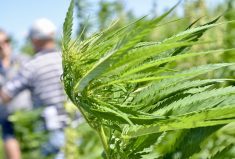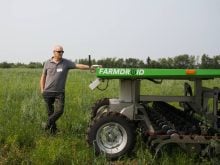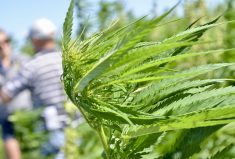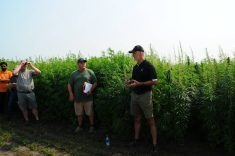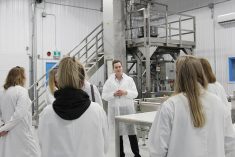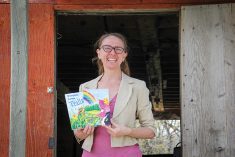Rod Fisher is an old hand at what is still a relatively new Canadian crop — hemp.
When production was legalized in 1998, Fisher and his two brothers obtained a Health Canada licence and dipped their toes into the water with a few dozen acres.
Today, they plant between 1,500 and 1,600 acres each year.
“We were working with Canterra seeds when hemp first came in… it was a distributor and it just kind of grew from there,” Fisher said. “We tried a field audit and it worked well.”
Read Also

Journal pulls long-cited glyphosate study for ethics violations
The journal Regulatory Toxicology and Pharmacology has retracted a 2000 Monsanto-linked glyphosate review, drawing new scrutiny as Bayer faces mounting legal pressure.
Good fit
Part of the crop’s appeal is that it can be seeded late in the season after wet fields dry out, Fisher said, adding he’s harvested mature plants after seeding as late as July 6 or 7.
“It’s a unique crop,” said Fisher. “And on our farm it’s been one of the better-paying crops.”
But while hemp can be grown for seed and fibre in Canada, producers are still shut out of the potentially lucrative nutraceutical market.
“It’s a lost opportunity,” Fisher said.
Keith Watson, an agronomist and plant breeder with Parkland Industrial Hemp Growers Co-op, agrees with that assessment. While many Canadians herald cannabis legalization as the way to increase the availability of CBD or cannabidiol, which is prized as a potential anxiety medication and anti-convulsive, Watson notes hemp also produces the medically significant cannabinoid.
“We’re into hemp and we’ve always consciously made a distinction between hemp and marijuana and kept it separate, so we don’t want to cloud it with that issue,” Watson said. “But we have developed (hemp) varieties which are higher in CBD.”
While only a small portion of the hemp plant — the brac surrounding the seeds — contains cannabidiol, the agronomist argues it could go a long ways towards supplying a medical market.
“Agriculturally we could supply them and it would be a huge opportunity, but the regulations are holding us back,” said Watson. “Even if you were only getting five per cent of it, you’d still be getting a lot of it to supply that medical market.”
Whole plant
Organizations like the Canadian Hemp Trade Alliance are pushing Health Canada to move towards allowing the entire hemp plant to be used and away from regulations created in an era when cannabis was seen as a dangerous and forbidden narcotic.
President Russ Crawford said the organization has met with Bill Blair — the police chief turned politician who led the government’s task force on cannabis legalization — and hopes their concerns have reached the right people.
“The prime minister has said that the goal is to make marijuana legal by July 1, 2018. Our request of that process is to exclude industrial hemp from those regulations and to acknowledge that it is different and it should not be treated in the same fashion,” Crawford said. “And the reason we’re asking that is because we don’t want to get caught up in a regulatory structure that will be heavily monitored and heavily controlled.”
Hemp doesn’t produce the psychotropic cannabinoid THC or tetrahydrocannabinol, but it is still regulated by the Controlled Substances Act.
“So it’s considered to be a narcotic and it’s treated in the same fashion as heroin and cocaine. It was simply done that way because there was not really the ability to distinguish industrial hemp from marijuana when this act first came into place,” Crawford explained. “Industrial hemp regulations were developed as an enabling legislation to allow for the production of hemp. So it’s our friend, it’s not our enemy, but it’s also becoming limiting in terms of what you can and can’t do.”
Valuable market
According to a report completed by The Hemp Business Journal, the market for CBD and CBD-containing products could reach a sales value of $2.1 billion by 2020 in the United States alone, about a quarter of which is expected to come from hemp. Canadian imports could be a big part of U.S. sales if the regulatory environment was more conducive to exports, said Crawford.
Proponents of CBD tout it as a cure for everything from diabetes and acne, to fibromyalgia, schizophrenia and mad cow disease, but research into the isolate is in its infancy, with most scientific inquiries focused on its effect on seizures.
But health claims can be made with cannabis products and Health Canada has already approved products containing cannabinoids. These products are classified as “therapeutic” under the Food and Drugs Act and are reviewed for safety, quality and efficacy, said a Health Canada spokesperson.
“Health Canada is aware that the hemp sector has proposed regulatory reforms that would permit hemp producers to use the whole hemp plant, including the leaves and flowers that producers are currently required to destroy under the existing framework,” the spokesperson continued. “Health Canada will be considering these and other stakeholder views as it prepares new regulations under the proposed Cannabis Act.”
Some interim changes to the oversight of industrial hemp have already been made. In 2016 an exemption was issued under the Controlled Drugs and Substances Act to better align industrial hemp regulations with its “demonstrated low public health and safety risk.” One example of this was the elimination of THC testing for most crops and the extended validity of licences, allowing the sale and purchasing of products grown in the previous year.
Farmer benefit
Crawford believes that if Canada moves forward prudently, hemp could open the door to countless products and opportunities, positioning Canadian producers at the forefront of a growth sector.
“There’s a financial benefit to farmers and there’s the financial potential of a value-added industry being developed in Canada,” he said. “It’s challenging to grow, but we’re developing varieties that are easier to harvest and more suited to their agricultural applications.”
But with so many hurdles still ahead, Watson said hemp needs help to break into the mainstream and out of its regulatory confines. “It needs all the lobbying it can get, people need to know about the benefits and why we can’t just harvest those parts of the plant,” the plant breeder said.
Dauphin-area hemp producers plan to introduce a resolution to lobby the federal government at the next Keystone Agricultural Producers meeting and the organization’s president Dan Mazier confirms the matter “is on their radar.”
But regardless of regulatory hurdles hemp production in the province continues to be on the upswing.
“There was a bit of a setback in 2016… acres were down a little, but it is a growing crop,” Fisher said. “Like any other new crop it’s got hiccups, ups and downs, but it is growing.”



